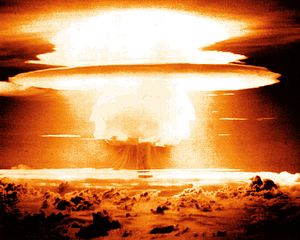French-Polynesia’s opposition party has announced that its future government will join the Marshall Islands in its International Court of Justice litigation against the nine nuclear states for breaching the Nuclear Non-Proliferation Treaty (NPT). Signing the treaty in 1968, the P5 states have committed to observing Article VI of the NPT, under which they are obliged “to pursue negotiations in good faith on effective measures relating to cessation of the nuclear arms race at an early date and to nuclear disarmament.”
In April 2014, the Marshall Islands brought claims against the nine nuclear weapon states of the United States, the United Kingdom, China, Russia, France, Israel, North Korea, India and Pakistan, arguing that their continued possession of nuclear weapons amounts to a breach of the NPT.
For Marshall Islanders, this activism was borne out of tragic first-hand experience. From 1946 until 1954 the United States used the Marshall Islands as a nuclear testing ground. To this end, the indigenous inhabitants of the Pikinni, Ron̄ļap, Wōtto, and Ānewetak atolls were forcibly resettled on outer island chains throughout 1946. As part of Operation Crossroads, two Hiroshima-size atomic tests were carried out, decimating Pikinni. These would be the first of a further 65 nuclear weapon trials within a twelve-year period.
Shielded from international attention, the U.S. carried out this testing with virtually no UN supervision. The experiment wreaked havoc on fragile Pacific ecosystems and, in some cases, changed the basic geography of the Marshall Islands forever. One such instance was the Mike test of November 1952, a bomb 750 times larger than the one dropped over Hiroshima, which vaporized the entire island of Elugelabl.
1954 saw the biggest test yet, with the Castle Bravo bomb – approximately 1300 times larger than Hiroshima – dropped over Pikinni on March 1, a date remembered by the Ron̄ļap islanders as the “day of two suns.” It created a fireball four miles in diameter, vaporizing two islands and spreading a fallout zone of thick radioactive ash for 7000 square miles.
By 1963 the first cases of thyroid tumors, birth deformities, and severe growth retardation were diagnosed. The health and environmental impacts have no precedent in history; the magnitude of testing within the 1946-1954 period was the rough equivalent of 1.6 Hiroshima bombs detonating daily for twelve years.
Meanwhile, the indigenous peoples of French Polynesia have their own horrific stories to tell. Between 1960 and 1996, 196 weapons tests were carried out in French Polynesia by the French government, with recently de-classified documents revealing that during one 1974 test, Tahiti was exposed to 500 times the maximum allowed levels of plutonium fallout. Research has found a clear increase in thyroid cancer rates among people living within 1300 km of the tests, with one veterans’ organization reporting thyroid tumors among some 85 percent of their members who had been exposed to testing.
For many activists, the struggle for justice for the survivors of the Mururoa atoll testing has become conflated with the ongoing decolonization process, begun three years ago when the French government agreed to allow the French Polynesian territories to be re-classified as a non-self-governing territory. Moreover, the declaration of support for the Marshall Islands case by the Tavini Huiraatira opposition party this week comes on the heels of the 2014 decision by the Assembly of French Polynesia to seek nearly $1 billion in compensation from the French government for the decades of testing.
The application contends that stockpiling weapons, improving nuclear technology and weaponizing nuclear material are violations of legal obligations owed by the nine states to the international community. The Marshall Islands further argues that these norms have crystallized into customary international law, obliging all states to pursue disarmament.
Failure to observe this commitment is, however, unlikely to amount to a breach of international law. One reason for this is that out of the nine states, only India, Pakistan and the United Kingdom have actually submitted to the compulsory jurisdiction of the ICJ under Article 36(2) of the court’s statute. This means that the other six states must consent by special agreement to the court’s jurisdiction in this particular case in order for the matter to progress, which is highly unlikely.
As the NPT heads into its 46th anniversary in 2016, prevailing state practice towards its obligations indicates that disarmament has a long way to go. With a total of 15,700 warheads in the world today, it will be some time before it can be said that the obligations contained within Article VI are binding on all states as a matter of customary law.
As a tiny Pacific country, the Marshall Islands are clearly outclassed in the ICJ, and are regarded by many as fighting a losing battle. Whilst Tavini Huiraatira has hinted that further Pacific Island countries will be joining the litigation in the near future, growing support is unlikely to have any effect on the solidifying NPT norms. Nevertheless, the litigation represents an important opportunity for these nations to tell their stories, to agitate for renewed commitment from signatory states, and to inject further impetus into the global disarmament movement.
Sally Andrews is a New Colombo Plan Scholar and the 2015-2015 New Colombo Plan Indonesia Fellow. She is a Director of the West Papuan Development Company and contributes to the Insights blog as part of her work as the 2016 Indo-Pacific Fellow for Young Australians in International Affairs. This article was first published on the Young Australians in International Affairs blog. It is reprinted with kind permission.

































